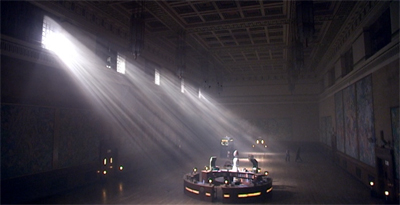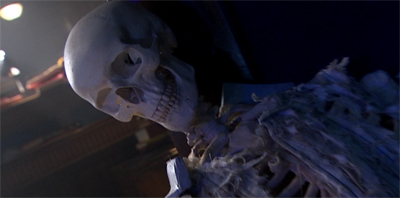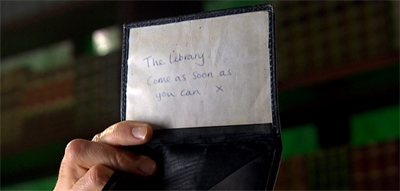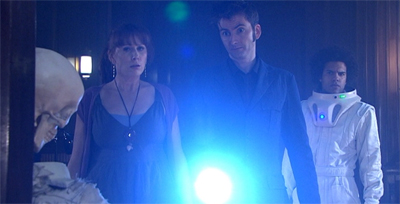To celebrate the fiftieth anniversary of the longest-running science-fiction show in the world, I’ll be taking weekly looks at some of my own personal favourite stories and arcs, from the old and new series, with a view to encapsulating the sublime, the clever and the fiendishly odd of the BBC’s Doctor Who.
Silence in the Library originally aired in 2008.
There’s the real world, and there’s the world of nightmares. That’s right, isn’t it? You understand that?
Yes, I know, Doctor Moon.
What I want you to remember is this, and I know it’s hard. The real world is a lie, and your nightmares are real.
– Cal and Doctor Moon get to the root of what makes Moffat scripts terrifying
Ah, Silence in the Library. The Steven Moffat story that isn’t, that doesn’t. The first Steven Moffat script that isn’t the strongest story in its season by a clear margin; the first Steven Moffat adventure that didn’t claim the Hugo for Doctor Who. The biggest problem with Silence in the Library and Forest of the Dead is that they can’t quite measure to The Empty Child, The Doctor Dances, The Girl in the Fireplace or Blink. That’s hardly an unforgivable sin, and there’s no shame in not being quite as good an episode of Doctor Who as Midnight was.
I’m quite fond of the two-parter, even though I’ll concede that it has its problems. The most obvious of which is the fact that – four years into the revival – the audience has had a chance to come to appreciate “Moffat-isms”, with many viewers able to recognise the writer’s preferred genre tricks and tropes. Silence in the Library is far from the most original script of the season, but it’s well written and well executed.
It’s just a little too familiar.
Then again, perhaps some of that is familiar. This is Russell T. Davies’ fourth season of Doctor Who. There’s a sense of celebration in these thirteen episodes. Part of that celebration involves an enthusiastic embrace of the classic series, with shout-outs to episodes like The Romans or The Sensorites or Survival. However, there’s also some recognition for the leaps and bounds that the show has made since it returned to the airwaves. In particularly, there have been quite a few nods to the work Moffat has already done on the show.
The Poison Sky featured the Doctor himself borrowing Moffat’s memetic catchphrase from The Empty Child while wearing a gas mask. The Fires of Pompeii chose to end its stinger with the Doctor stealing another line from that episode, as Jack referenced “volcano day.” Given that Moffat had agreed to succeed Davies as the series entered production, this feels strangely appropriate – celebrating the handing of the reins from one writer to another.
Logically, Silence in the Library and Forest of the Dead become part of this celebratory atmosphere. Indeed, they reach right back to the first season of the revived show. Davies has tasked Steven Moffat with writing the second two-parter of his final season, the same two-parter he assigned Moffat to write for the first year of the resurrected show. Silence in the Library is a collection of Moffat tropes and storytelling tricks, but it also goes right back to the first of Moffat’s scripts for the revived series.
“Hey, who turned out the lights?” is a conscious attempt at a monster catchphrase in the same way that “are you my mommy?” was in The Empty Child, even if it never works quite as well. River Song makes a lot more sense if read as a counterpart to Captain Jack, the character Moffat only wrote once in his début appearance, but wrote very well. The adventure features the uncomfortable acknowledgement of a dark family secret, and even ends on the same “everybody lives” sentiment as The Doctor Dances did three years earlier.
Of course, there are other familiar Moffat storytelling elements to be found here. The episode features Moffat making something very mundane scary, as he did in Blink; there it was statues, here it is shadows. There’s an undercurrent of technology gone wild, trying to help, but screwing up massively; a plot device Moffat used in both The Doctor Dances and The Girl in the Fireplace. The out-of-sequence romance from The Girl in the Fireplace feels like a precursor to Moffat’s work with River Song here, a character out of sequence with the Doctor.
It’s worth noting that none of these story elements are bad. None of them are inherently flawed. Indeed, there are lots of other writers on Doctor Who that have their own favourite storytelling tricks. Davies is fond of vaguely foreshadowed deus ex machina endings. Terrence Dicks’ work on the tie-in novels is famous for its own well-practised turns of phrase. Robert Holmes had a weakness for double acts and obstructive bureaucrats. It’s quite possible to spot the authorial voice of any number of Doctor Who writers quite quickly by paying attention to the narrative tropes they use.
Moffat is no different. He has his own particular favourite hooks and tricks to use. Under his tenure, the show has grown increasingly “timey wimey”, with each of his three completed seasons hinging on some sort of time-related narrative gymnastics. However, I’d argue that these are distinctive enough from one another that they have their own particular flavour and identity. The over-arching plot of the fifth season, involving a gigantic reset button, is distinct from the messed-up biography of River Song in the sixth season, and both are different from the mystery surrounding Clara during the seventh season.
However, there is something to be said for novelty. Moffat’s work on The Empty Child was so astounding because nobody really suspected that he had it in him. Moffat has a long history in television, but the bulk of his work before Doctor Who came back to television was in young dramas or sit-coms. Of course, in the years since he first worked on the series, Moffat has produced Sherlock and Jekyll, both successful examples of genre television, but he hadn’t done anything like that before Rose aired in 2005.
You could argues that Russell T. Davies was just as much of an unknown quantity at the time, but he was still a more comfortable fit when Doctor Who first went to air. While Russell T. Davies had produced something bold and provocative for British television in The Second Coming, Moffat was best known for Press Gang or Coupling. While Davies had pushed the boundaries of Doctor Who in his novel Damaged Goods, Moffat’s only previous contribution had been an affectionate spoof of familiar Doctor Who tropes in The Curse of Fatal Death, a Red Nose Day special.
So, when Moffat turned in The Empty Child and The Doctor Dances as his first scripts for the show, everybody was astounded. Moffat obviously did a good job with the areas of the brief that played to his strengths – the romantic comedy atmosphere between the Doctor and Rose and Captain Jack. However, that much was expected. Moffat was a celebrated sit-com writer. What was really astounding about The Empty Child and The Doctor Dances was how terrifying those episodes were. Moffat did scary incredibly well.
And then The Girl in the Fireplace happened. Before his second script aired, it would have been possible to write off The Empty Child and The Doctor Dances as flukes. However, Moffat’s second script confirmed that he was a talent to watch. Watching the show retroactively is fascinating, because you can connect threads. You can see the “timey wimey” ideas that are broached in The Empty Child and The Doctor Dances (Jack’s time travel con game) develop across The Girl in the Fireplace and Blink. Each time, the concepts become more elaborate, more complex.
However, there comes a point where you really reach a limit, a threshold of the sort of temporal mechanics you can play with over the course of a forty-five minute episode. Moffat really reached that point with Blink, which features the use of time travel to force people to “live themselves to death” and recorded conversations synchronised across decades. Once you reach that saturation point, you only have two real options. You can accept those limitations and work within them, or you can spread out beyond a single story.
From 2010 onwards, Moffat could – as showrunner – expand his time-travel arcs across entire seasons. However, in Silence in the Library and Forest of the Dead, he is really forced to accept the limitations of writing a single Doctor Who story. As a result, a lot of the episode feels familiar. The relationship between the Doctor and River Song, without the development that would be offered over the years ahead, feels like a retread of the romance between the Doctor and Madame de Pompadour, rather than a nice bit of set-up for Moffat’s tenure as executive producer.
Indeed, Silence in the Library feels rather nostalgic on Moffat’s part. Emails in The Writer’s Tale between Moffat and Davies suggest that Moffat was working on the script at the same time that he was considering Davies’ offer to run the show. It makes sense, then, that Silence in the Library feels like a trip down memory lane back to Moffat’s very first script for Davies, and maybe even beyond. Indeed, Silence in the Library sees Moffat engaging with the notion of Doctor Who as a franchise in a rather direct way, arguably as direct as he did back when he dropped Star Trek references into The Empty Child.
Like many Moffat scripts, Silence in the Library is concerned with glitchy technology. Here, however, there’s a decidedly meta-fictional bent to that glitchy behaviour. For most of Silence in the Library and Forest of the Dead, we keep cutting back to Cal. Cal is a young girl in a nice apartment with her father. Cal is watching the Doctor on television. Cal is watching Doctor Who on television. We get lots of shouting and screaming and hiding and laughing as she watches the Doctor navigate the threats in front of him, while she’s visited by a counsellor who helps her work through her fears and anxieties and nightmares.
One of the nicer sequences in Silence in the Library features the Doctor conversing to a little girl through her television set – a delightfully surreal sequence which looks like Attack of the Graske has been incorporated in the show’s narrative. Moffat makes it clear that, to Cal, she is watching a television show that involves lots of running around corridors. At the start of Forest of the Dead, Cal simply switches channels to watch a far more banal soap opera about a more ordinary life. This is an episode of Doctor Who which features a guest character watching Doctor Who.
In a way, it’s a logical extension of the celebratory mood of the fourth season. This season will climax with the decision to bring back pretty much anybody who has set foot in the TARDIS since 2005, so having a two-parter where a character sits around and watches Doctor Who doesn’t feel too strange or surreal – particularly when Doctor Who is one of the biggest things on British television. Cal is never the dominant focus of the episode, so it never becomes too painfully self-indulgent on the part of Moffat.
If Silence in the Library represents a trip down memory lane, setting it in a library feels strangely appropriate. When Doctor Who was cancelled, it was kept alive by a wide range of tie-in novels. These novels were written by a wealth of talented individuals who helped to keep Doctor Who relatively vibrant and modern. Many of these writers would go on to write for the new series – Russell T. Davies, Mark Gatiss, Paul Cornell, Gareth Roberts. In a large part, these books “saved” Doctor Who, keeping it in a form where it could eventually be restored for the viewing public.
Indeed, Silence in the Library also seems to reflect on Moffat’s own pre-Doctor Who career, with the Doctor himself pointing out that without death life is really comedy. “You need a good death,” the Doctor tells us. “Without death, there’d only be comedies. Dying gives us size.” Given that Silence in the Library and The Doctor Dances both ended with nice big “everybody lives” moments, it would seem that Moffat is suggesting that Doctor Who is really quite close to comedy, a genre he knows very well at this point.
There are other decidedly Moffat-esque touches. While Davies tends to treat the Doctor as “the Lonely God”, Moffat has always imagined him more like a fairy tale. So Silence in the Library really plays to this theme, which was a part of The Girl in the Fireplace. Murray Gold’s soundtrack as a decidedly “music box” feel to it, and the whole thing is framed almost like a half-remembered dream from a young girl. As she recounts her trip to the library, Doctor Moon asks, “How do you move around?” Cal responds, “By wishing.”
Similarly, Moffat teases the whole “Doctor’s name” thing here. River Song knows his name, even if it’s never revealed to the viewer. More than that, though, Moffat also manages to suggest that perhaps “the Doctor” is good enough for the character – with an emphasis on the definitive article. Discussing the library, the Doctor muses, “The Library. So big it doesn’t need a name. Just a great big The.” It seems only fair to suggest that the same might be true of himself – particularly when you consider River’s “we get that word from you” speech in A Good Man Goes to War.
Steven Moffat has a very particular way of approaching Doctor Who, and it’s already well-defined by Silence in the Library. It seems a little trite to criticise Moffat for “only” having a dozen or so truly great ideas for the show that he tends to revisit, and I suspect that part of the problem for the the backlash to Moffat is the fact that he’d already spent four years defining his own particular style of Doctor Who before he took over the running of the show.
Silence in the Library demonstrates a very structured approach to Doctor Who, but one that feels less fresh than the first or second or third time that Moffat adopted that approach. Moffat’s key technique is to find something innocuous and to make it terrifying. In The Empty Child, it was a little boy wearing a gas mask. In The Girl in the Fireplace, it was the tick of a clock. In Blink, it was a statue. Here, it’s a skipping audio track and shadows.
Of course, shadows are terrifying any way, even before Moffat suggested that “piranhas of the air” were swimming around in them. “Every shadow?” River asks. “No,” the Doctor responds. “But any shadow.” Fear of the dark is one of the most primal fears, and so it makes sense for Moffat to riff off that. “Almost every species in the universe has an irrational fear of the dark,” the Doctor explains. “But they’re wrong, because it’s not irrational.” That’s a nice hook, even if “shadows” are – on a visual level – lot harder to make menacing on a BBC budget than a kid in a gas mask or a clock work robot or a statue of an angel.
Familiarity breeds contempt, or at least apathy – and I suspect that plays a large part in why Silence in the Library isn’t as well-regarded as some of Moffat’s other episodes. We’ve seen pretty much all of these tricks before, so assembling them as part of a two-parter from the man-who-would-be-show-runner can feel a little disappointing. That’s hardly the most justified of criticisms, but it is definitely part of what makes Silence in the Library feel so strange.
That said, there are other problems. Forest of the Dead, the episode’s second part, has some pretty major gender issues – which we’ll talk about. More than that – watching the two-parter as a whole – there’s a sense that Moffat doesn’t really understand Donna Noble as a character. In the opening scenes of the episode, Donna gets relatively little dialogue, while the Doctor monologues away to himself. Donna doesn’t really get to be too interested in the Library itself, and she falls back into a very traditional companion role here.
Donna is appalled by the donated faces, so the Doctor can remind her about relativism, and she has two separate “screaming companion” scenes in the two-parter. The Doctor pretty much tries to brush her out of the way when things get complicated at the end of the first episode, one of the rare points in the fourth season where the show doesn’t treat Donna as a character who is just as strong-willed and stubborn as the Tenth Doctor. After all, the whole point of Donna as a character is that the Doctor can’t just shut her up with his technical wizardry.
To be fair, part of the problem is down to episode scheduling. This is the last adventure featuring the pair before the Doctor- and companion-lite episodes leading into the massive finalé featuring every major companion from the revived series. This is really the last chance the show has to focus on the Doctor and Donna as a team, so it feels quite disappointing that Moffat pushes Donna so rapidly to the background and then separates the Doctor and Donna for the second part of the adventure.
As a result, it feels like the last story in the season to focus on the Doctor and Donna was The Unicorn and the Wasp, the seventh episode of thirteen, making it seem like the pair stopped functioning as a team half-way through the season. Given how much emphasis the fourth season puts on the Doctor and Donna as equals, and how wonderfully Tate and Tennant work together, it can’t help but feel like a bit of a waste.
I’ll confess that Silence in the Library and Forest of the Dead are a mixed bag – arguably much more Forest of the Dead than Silence in the Library. Still, there’s a lot to like here, and a lot that reflects the season around it. This is really Moffat’s last proper adventure as a freelance writer, before he’s handed the keys to the kingdom and tasked with actually maintaining a massive multimedia franchise for the BBC. As such, the nostalgic atmosphere and the sense that this is a trip down memory lane all feel quite appropriate.
You might be interested in our other reviews from David Tennant’s third season of Doctor Who:
- Partners in Crime
- The Fires of Pompeii
- Planet of the Ood
- The Sontaran Stratagem/The Poison Sky
- The Doctor’s Daughter
- The Unicorn and the Wasp
- Silence in the Library/Forest of the Dead
- Midnight
- Turn Left
- The Stolen Earth/Journey’s End
Filed under: Television | Tagged: arts, bbc, doctor, Doctor Dances, DoctorWho, Empty Child, Library, Moffat, River Song, russell t. davies, science fiction, Silence in the Library, steven moffat |



































Leave a comment